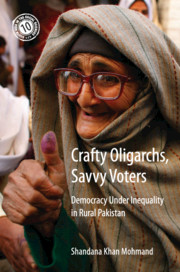Book contents
- Frontmatter
- Dedication
- Contents
- List of Tables and Figures
- Acknowledgements
- Glossary of Local Terms
- 1 Introduction: Rural Voters under Inequality in an Emerging Democracy
- 2 Colonial Constructs and Post-colonial Politics: 1849–2018
- 3 Landed Power in Sahiwal: From Domination to Intermediation
- 4 Local Competition and Bargaining Power: Conceptualising Political Engagement in Rural Punjab
- 5 Bargaining with Landlords: Comparing Political Engagement in Unequal Contexts
- 6 Structural Inequality and Variations in Political Engagement
- 7 When Do Shifts in Political Engagement Occur?
- 8 Conclusion: The Future of Pakistan's Democracy
- Annex 1 Chronology of Political Events in Pakistan
- Annex 2 Index of Political Engagement (IPE) Scores for 38 Villages
- Annex 3 Research Instruments
- Annex 4 Detailed Descriptions of Household Variables Used in Multivariate Regression Analysis
- Bibliography
- Index
Annex 3 - Research Instruments
Published online by Cambridge University Press: 26 April 2019
- Frontmatter
- Dedication
- Contents
- List of Tables and Figures
- Acknowledgements
- Glossary of Local Terms
- 1 Introduction: Rural Voters under Inequality in an Emerging Democracy
- 2 Colonial Constructs and Post-colonial Politics: 1849–2018
- 3 Landed Power in Sahiwal: From Domination to Intermediation
- 4 Local Competition and Bargaining Power: Conceptualising Political Engagement in Rural Punjab
- 5 Bargaining with Landlords: Comparing Political Engagement in Unequal Contexts
- 6 Structural Inequality and Variations in Political Engagement
- 7 When Do Shifts in Political Engagement Occur?
- 8 Conclusion: The Future of Pakistan's Democracy
- Annex 1 Chronology of Political Events in Pakistan
- Annex 2 Index of Political Engagement (IPE) Scores for 38 Villages
- Annex 3 Research Instruments
- Annex 4 Detailed Descriptions of Household Variables Used in Multivariate Regression Analysis
- Bibliography
- Index
Summary
Research instruments used in case study villages
Qualitative field notes based on ethnographic observations.
Open-ended interviews with 15–20 key respondents per village.
Surveys with about 35–45 per cent of randomly selected households per village using questionnaires that probed networks and relations within the village. This generated a dataset of about 700 households.
Census surveys of the full village population to get data on land inequality, literacy rates, poverty and demographic composition in terms of caste and kinship groups.
Archival data on village history and historical land inequality using colonial Village Inspection Reports from the archives of the District Revenue Office.
Research instruments used in survey villages
Structured interviews with 2–3 key respondents per village.
Surveys with 45 randomly selected households per village, which generated a dataset of 1,572 households in total.
Census surveys of the full village population to get data on land inequality, literacy rates, poverty and demographic composition in terms of caste and kinship groups. This rendered a dataset of over 9,000 households.
Archival data on village history and historical land inequality using colonial Village Inspection Reports from the archives of the District Revenue Office.
- Type
- Chapter
- Information
- Crafty Oligarchs, Savvy VotersDemocracy under Inequality in Rural Pakistan, pp. 273Publisher: Cambridge University PressPrint publication year: 2019



